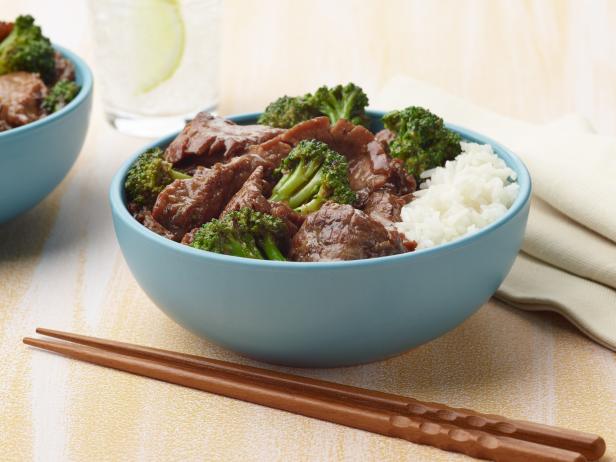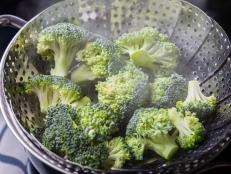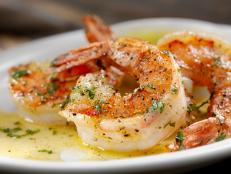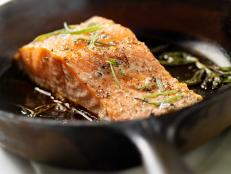Why the Meat in Chinese Stir-Fries Is So Wonderfully Tender
It’s all thanks to velveting, a technique that gives Chinese dishes their signature texture. Here’s how to do it at home.

Renee Comet
Order kung pao chicken or beef with broccoli at any Chinese or Chinese American restaurant and you’ll notice the texture of the meat – light, tender, succulent and flavorful. But it’s not the use of a wok or high heat alone that yields the signature texture. It’s all thanks to a simple technique called velveting – and it happens before you even turn on the stove.
“Velveting is the foundation of Chinese cooking,” says Tim Ma, chef and founder of Lucky Danger, an American Chinese takeout spot with locations in Arlington, VA, and Washington, D.C. “It doesn’t only tenderize tough, chewy parts of proteins, but it also creates a surface area to absorb thick sauces.”
In Chinese cooking, proteins like beef, pork or chicken are velveted first before stir-frying them. There are several ways to velvet, but at its most basic level, it involves marinating meat with at least one ingredient that will make it alkaline. This is what tenderizes the meat, especially cheaper, tougher cuts. “People go for either egg white or baking soda as they are both alkaline ingredients. If you don’t add egg, it’s generally important to add a little bit of water to make the mixture liquid and properly coat the meat,” says Kathy Chen, head chef at Wenwen, a cozy Taiwanese eatery in Brooklyn.
Kaitlin Leung of The Woks of Life, a blog dedicated to Chinese cooking, shares that a standard velveting mixture could include egg white and cornstarch, plus a few tablespoons of water – to help coat the meat yes, but also to make the meat extra tender and juicy. It’s typical to also marinate with ingredients like soy sauce, Shaoxing wine, oyster sauce or white pepper.
Seafood like fish, shrimp, and scallops can also be velveted though there are a couple things to keep in mind. “For tender seafood like squid or scallops, velveting is typically unnecessary. In most cases you want to preserve their fresh taste and natural texture,” says Leung. “For shrimp, you can velvet it unless they are super fresh. Some do it religiously, but we usually prefer to keep its natural texture and simply season it when needed. For fish, velveting adds an extra silky texture.”
To complete the velveting process, some cooks recommend dipping the marinated morsels in peanut oil for less than one minute on active fire. This method, known as oil-blanching, ensures ingredients don’t clump together and stick to the wok when stir-frying.
If peanut oil is unavailable, award-winning cookbook author Grace Young suggests using oil with higher smoke points like grapeseed, avocado, rice bran, safflower or vegetable oil. Sesame oil or extra virgin olive oil, for instance, is not recommended because they tend to have lower smoke points.
While oil-blanching can require a lot of oil, you can also blanch meat in water. For this method, bring the water to a boil on high heat, add one tablespoon of peanut or vegetable oil, reduce the heat to low and when the water is barely simmering, carefully add the meat and gently stir so the pieces don’t clump together. Cook for one minute or until the meat just turns opaque but is not cooked through.
Water-blanching is recommended for home cooks as Young, quoted from her cookbook Stir-Frying to the Sky’s Edge, says it is less complicated, reduces the amount of oil necessary for stir-frying and results in dishes that taste less fatty. It also yields a purer flavor and softer texture, says Leung. “It might seem counterintuitive to marinate before boiling, but the velveting marinade tenderizes the meat, keeps it moist, and adds flavor. The meat ends up juicy and flavorful, a result you don’t get with a standard blanching process.”
However, oil- nor water-blanching is absolutely necessary, especially for home cooking. Randy Lau, the creator of Made With Lau, a Cantonese cooking blog and YouTube channel, shares that 60 percent of his father’s (the chef and culinary expert behind Made With Lau) Chinese recipes skip this step. “Often times, we don’t oil- or water-blanch proteins and the meat texture is still tender though not restaurant-quality level,” Lau says. Instead, when it comes to stir-fries, several Made With Lau dishes involve marinating proteins properly with an alkaline ingredient, and then employing a stir-frying method that ensures they stay tender and don’t overcook.
When Daddy Lau (as he is affectionately called) cooks Kung Pao Chicken, for instance, he stir-fries the protein until it’s 80 to 90 percent cooked, then scoops it out of the wok and sets it aside. He then cooks the other ingredients, and then when everything’s just about fully cooked, adds the chicken back in to finish it off and combine with the other ingredients. Finally, sauce is added to bring the whole dish together. “We individually stir-fry the ingredients because our home stoves generally aren’t as powerful as those in restaurants. It’s also more of a timing issue,” says Lau.
Randy’s dad still applies the water-blanching method when cooking soups. This is to filter out the coagulated protein, enhance the quality of the soup and achieve purity of the broth.
“My dad is all about convenience and making food approachable,” says Lau. So if a recipe doesn’t include blanching, it’s often because it won’t make or break a dish.
Whether you go with the simplest approach, or more advanced restaurant-grade methods, velveting makes a huge difference, and is an essential step to making any stir-fry dish top notch. Here are some tips to keep in mind.

LauriPatterson/Getty Images
Pat Proteins Dry
When preparing your proteins, be sure to pat them dry before velveting, so you’re not diluting your slurry ratio, says Ma. If using shrimp or scallop, make sure to shake out the water before combining it with any egg white-cornstarch mixture. Excess water dilutes the effectiveness of the coating, according to Young.
Make Sure Your Cornstarch Is Fully Dissolved
Cornstarch is the foundation of Chinese cooking and this magical pantry ingredient is commonly used to thicken soups, stews and sauces. It’s also the primary ingredient in making a slurry to coat the meat. Chen says cornstarch helps the meat retain moisture while it cooks, thus yielding a silkier texture.
When using cornstarch with other ingredients, stir it well until it’s fully dissolved, and no clumps are visible. Ma suggests making the slurry first separately, then adding that to the meat and making sure it’s thoroughly incorporated. Wen agrees and says, “I would recommend mixing all the marinade ingredients together very well before adding in your meat. This will help ensure an even coating on all the ingredients and make the whole mixture an even pH [level].”
While there are several ways to velvet, a pound of meat needs about two teaspoons of cornstarch and two teaspoons of oil, says Leung. You may also include two to three tablespoons of water. For beef, add a 1/4-teaspoon of baking soda for tenderizing. Additional seasonings are optional and vary from recipe to recipe.
Limit The Use of Egg Whites
Young suggests using about two tablespoons of egg white for every one pound of meat, poultry, fish or shellfish. If too much egg white is used, the mixture won’t be absorbed and seal the meat’s juices well.
Don’t Have a Deep Fry Thermometer? Get One
Blanching meat in oil comes from the Chinese phrase zǒu yóu in Mandarin or jau yau in Cantonese, which means “passing through oil.” It simply refers to shallow frying or deep-frying. “The process of searing or frying meat in oil varies a little for different kinds of meat and the volume of what you are working with,” says Leung. “Delicate fish can benefit from a little extra oil to make sure the tender pieces of fish aren’t too dry, risking breakage in the wok.”
When choosing to blanch meat in oil, be sure to have a deep-frying thermometer with you so you know precisely when the oil reaches 350 Fahrenheit, according to Ma. He suggests adding meat one piece at a time, so it doesn’t clump once it hits the oil. Exercise care when adding or removing ingredients to and from the hot liquid. Young also suggests using a dry wok skimmer or slotted metal spoon to carefully transfer the marinated ingredients without splashing.
Thoroughly Get Rid of Excess Water
If you blanch meat in water, Young suggests having a colander ready in the sink, drain the pieces in the colander, and thoroughly shaking out any water before stir frying. Any excess moisture will create extra spattering from the hot oil when pieces are added to the wok, in addition to turning your stir-fry into a braise, as quoted in her cookbook.

Matt Armendariz
Ready to perfect your velveting technique, and sink your teeth into magically tender dishes? Give Vivian Chan’s Chicken Stir-Fry or Jet Tila’s Beef and Broccoli a try. Or add velveted meat to stir-fried noodle dishes like Classic Lo Mein or Andy Liang’s Singapore Mei Fun.
Related Content:































































